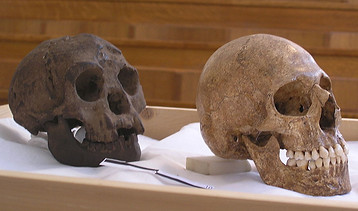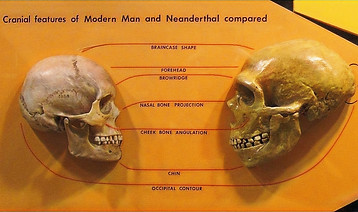

Human Evolution
Early Primates
The evolutionary history of primates dates back 65 million years. Early primate-like mammals lived in North America and China. The primate lineage that led to humans and African apes came from Europe or Asia and migrated to Africa.
Fossils from the Early Miocene show a diverse range of primates in East Africa. The Middle Miocene saw a wide range of primates across Africa and Europe. The earliest known catarrhine (a type of primate) is Kamoyapithecus, from 24 million years ago.
The lineages of gibbons and orangutans diverged from other great apes around 18-12 million years ago. Hominids (including humans) diverged from orangutans around 14 million years ago. The human genus (Homo) emerged around 2 million years ago, and anatomically modern humans emerged in Africa around 300,000 years ago.
emerging in Africa around 300,000 years ago.

Australopithecus
The Australopithecus genus, a group of early human ancestors, evolved around 4 million years ago in eastern Africa. Over time, different species of Australopithecus emerged, including Au. anamensis, Au. afarensis, Au. africanus, and others. Some scientists debate whether certain species, such as Au. robustus and Au. boisei, should be considered part of the Australopithecus genus or a separate genus called Paranthropus.
The Australopithecus genus is thought to have gone extinct around 2 million years ago. However, there are some recent discoveries that suggest the genus may be older than previously thought. One example is a new species called Australopithecus deyiremeda, which is claimed to have lived at the same time as Au. afarensis. Another example is Australopithecus prometheus, also known as Little Foot, which has been dated to 3.67 million years old using a new dating technique.
Little Foot's fossilized remains show that it had an opposable big toe, which suggests that it was a good climber. Scientists believe that Little Foot likely built a nesting platform in trees at night, similar to how chimpanzees and gorillas do today.

Homo habilis
Homo habilis, a human ancestor, lived from 2.8 to 1.4 million years ago. It evolved in Africa around 2.5-2 million years ago and was characterized by smaller molars and larger brains. This species is known for making tools from stone and possibly animal bones, earning its name "handy man" from Louis Leakey. Some scientists suggest that Homo habilis may not be a member of the Homo genus, but rather should be classified as an Australopithecus due to its skeletal features, which are more adapted for tree-dwelling than walking on two legs like later humans.
.png)
Homo rhodesiensis
Rhodesian Man, estimated to be between 300,000 and 125,000 years old, is a ancient human species that has been classified as a member of the Homo heidelbergensis group by most researchers. However, some scientists have proposed alternative designations, including archaic Homo sapiens and Homo sapiens rhodesiensis.
In 2006, a significant fossil discovery was made in Ethiopia, which could potentially shed light on the evolution of human species. The Gawis cranium, believed to be between 500,000 and 250,000 years old, is still being studied and has not yet been published in a peer-reviewed journal. The facial features of the Gawis cranium suggest that it may be an intermediate species between Homo erectus and Homo sapiens, or an example of a "Bodo man" female.

Homo floresiensis
The species Homo floresiensis, also known as the "hobbit", lived on the island of Flores in Indonesia around 190,000 to 50,000 years ago. It was a small species, with adults estimated to be around 1 meter tall and having a brain volume of only 380 cm3, which is smaller than a chimpanzee's brain. The most well-known find is a 30-year-old woman's skeleton, which has been dated to around 18,000 years ago.
However, there is a debate among scientists about whether H. floresiensis is a separate species or not. Some argue that it could have been a modern human with a pathological condition that caused dwarfism. Others argue that it was a separate species due to its unique anatomical features, such as the shape of its bones and cranial features.
In 2016, additional fossils were discovered that are believed to be ancestral to H. floresiensis. These fossils, found at Mata Menge, date back to around 700,000 years ago and are even smaller than the later fossils. This discovery provides further evidence that H. floresiensis is a distinct species.

Great Apes
The article discusses the evolution of humans and their closest relatives, gorillas and chimpanzees. The fossil record shows that humans split off from a common ancestor with gorillas and chimpanzees around 8-4 million years ago.
The earliest human fossils were found in Africa and date back to 7-4 million years ago. A study of one of these fossils, Ar. ramidus, suggests that early humans may have evolved in a way that's similar to how bonobos (a type of chimpanzee) behave. This could mean that early humans were more peaceful and social than previously thought.
The study also suggests that many human traits, such as our ability to live in forests and woodlands, may have evolved earlier than we thought. This could mean that humans didn't evolve directly from chimpanzees, but rather from a more primitive ancestor that shared characteristics with both gorillas and chimpanzees.

Homo
The human genus Homo evolved over millions of years. The earliest known species, Homo habilis, emerged around 2.8 million years ago and used stone tools. Its brain size was similar to that of a chimpanzee.
Over time, Homo erectus and Homo ergaster evolved, and their brain size doubled to 850 cubic centimeters. These species were the first to use fire and complex tools, and they left Africa around 1.3-1.8 million years ago.
Modern humans, Homo sapiens, evolved in Africa around 50,000-100,000 years ago. Early humans migrated out of Africa, replacing local populations of other human species.
Recent DNA evidence suggests that Neanderthals and other ancient human species may have contributed to the modern human genome. The transition to behavioral modernity with symbolic culture, language, and specialized tools also occurred around 50,000 years ago.
There are ongoing debates about the classification of extinct Homo species and the evolution of human species from Homo habilis to Homo sapiens. Two alternative theories are the Sahara pump theory and the Toba catastrophe theory, which propose different explanations for early human migration and population decline.

Homo erectus
The first fossils of Homo erectus were discovered in 1891 by Dutch physician Eugene Dubois on the Indonesian island of Java. Initially, Dubois thought they were a chimpanzee-like primate, but later realized they were more human-like. In the 20th century, paleoanthropologist Franz Weidenreich compared these fossils to those found in China and concluded that they should all be classified as a single species of Homo, H. erectus.
Homo erectus lived from around 1.8 million to 70,000 years ago, with some scientists suggesting that they may have been wiped out by the Toba catastrophe. The early phase of H. erectus is sometimes considered a separate species, H. ergaster, or a subspecies of H. erectus.
In Africa, Homo habilis evolved into a new species, Homo erectus, around 1.5-1 million years ago. This species had larger brains and made more advanced stone tools than Homo habilis. They may have also used fire to cook meat and had adaptations such as locking knees and a changed position of the foramen magnum. Some scientists believe that control of fire and cooking was the key adaptation that separated Homo from tree-sleeping Australopithecines.
_presented_at_Paleozoological_Museum_of_China.jpg)
Homo neaderthal
Neanderthals, who lived 400,000 to 28,000 years ago, had some physical and brain differences compared to modern humans. They had bigger brains, which might have been needed for their physical size. They also had better eyesight than modern humans.
At first, scientists thought that Neanderthals didn't mix with modern humans. But DNA tests showed that they did interbreed around 45,000 to 80,000 years ago. This means that many modern humans outside of Africa have a small amount of Neanderthal DNA in their genes.
Scientists also found another human species called Denisovans, which lived around the same time as Neanderthals. Denisovans mixed with both Neanderthals and modern humans, and their DNA can still be found in some people today.
There's evidence that genes also flowed from modern humans to Neanderthals, and that Neanderthals and modern humans might have interbred around 100,000 years ago. This means that our species are more closely related than we thought.
Overall, studying Neanderthals and other human species has helped us learn more about how our species evolved and changed over time.

Homo sapiens
The human species, Homo sapiens, originated in Africa around 300,000 years ago, likely from a common ancestor with Homo heidelbergensis. The earliest modern humans emerged between 260,000 and 350,000 years ago through a mixing of populations in East and South Africa. Over time, humans evolved from Homo erectus to Homo sapiens, with a migration out of Africa and subsequent replacement of earlier human species. Humans also interbred with other archaic human species, such as Neanderthals and Denisovans, both in Africa and Eurasia. A theory that suggested a massive population bottleneck 70,000 years ago has been largely discredited. The human species has developed distinct genetic variations due to factors such as the founder effect, archaic admixture, and recent evolutionary pressures.
